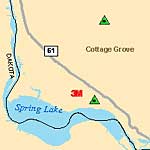 |

By Mike Edgerly, Minnesota Public Radio,
and Sasha Aslanian, American RadioWorks
February 2005
 Listen to the report
Listen to the report
3M announced in 2000 that it was phasing out its popular Scotchgard product, because the anti-stain spray contained chemicals toxic to lab animals. The chemicals had also turned up in the blood of 3M workers, though the company said its employees were not harmed.
3M produced the chemicals at its plant in Cottage Grove, Minnesota. An investigation by Minnesota Public Radio and American RadioWorks found that even after 3M said it would no longer make the toxic chemicals, the Minnesota Pollution Control Agency let two years pass before it began any inquiries.
The story raises questions about who is responsible for the safety of the public and the environment, and about whether state agencies are doing enough to protect citizens from toxic chemicals.



|
 |
 The chemistry of Scotchgard
The chemistry of Scotchgard
Until 2000, 3M was the sole manufacturer of the perfluorinated chemicals used in Scotchgard and DuPont's Teflon. Those chemicals stay in the environment, and have contaminated drinking water in at least one Minnesota city.
|

| ||



|
 |
 Questions from the community
Questions from the community
Before there was an MPCA or a Superfund cleanup program, people who lived near 3M's Cottage Grove plant and its nearby landfill in Woodbury had questions about their safety.
|

| ||




|
 |
 3M's
handling of the situation
3M's
handling of the situation
Much of what is known
about perfluorochemicals comes from manufacturers like
3M, which has researched them for years. 3M is facing
several lawsuits over contamination. |
 | ||




|
 |
 What happens next?
What happens next?
The research into perfluorochemicals is being ramped up, even as thousands of other such substances remain unregulated and unstudied.
|
 | ||

|
 |
 The long reach of perfluorochemicals
The long reach of perfluorochemicals
These chemicals are widespread around the world, found in the U.S. blood supply, the blood of 3M plant workers, as well as fish, birds and animals living far from chemical factories.
|
 | ||
|  |


It's been 50 years since Scotchgard came on the market, and five years since it was removed.
In between are many milestones to mark the spread, and study, of perfluorochemicals.
 See highlights of that history. See highlights of that history.



The 3M plant and the landfills in question are located in Washington County, on the east side of the Twin Cities metro area.
 See a map of the area.
See a map of the area.


This story came about as a result of two tips picked up by Sasha Aslanian of American RadioWorks. It's a highly charged issue, as she and Mike Edgerly discovered during the course of their reporting.
 Read Sasha's observations. Read Sasha's observations.


Has the discovery of perfluorochemicals in drinking water in the east metro touched your family? If so, how? Have you changed your water consumption because of the discovery of perfluorochemicals?
 Share your thoughts. Share your thoughts.
 Read what others are saying. Read what others are saying.


Various state and federal agencies have collected information about perfluorochemicals.
 See a list of resources and links. See a list of resources and links.


Producers: Mike Edgerly, Sasha Aslanian
Editors: Catherine Winter, Stephen Smith
Executive Producer: Bill Buzenberg
Online Editor: Melanie Sommer
Web design: Ben Tesch
Audio Engineer: Craig Thorson
Researcher: Betsy Cole
Production assistance: Melody Ng, Nate Hall, Ben Schmidt, Marta Berg and Alex McCrae
|

|  |
|  |









